Bank Reconciliation and Suspense Account
VerifiedAdded on 2020/11/23
|8
|1393
|370
Project
AI Summary
This assignment explores the crucial aspects of bank reconciliation, focusing on identifying discrepancies between the cash book and bank statements. It delves into the process of rectifying errors through journal entries and highlights the significance of a suspense account in resolving unresolved items during reconciliation. The document emphasizes the importance of accurate financial reporting and the role of bank reconciliations in ensuring its integrity.
Contribute Materials
Your contribution can guide someone’s learning journey. Share your
documents today.
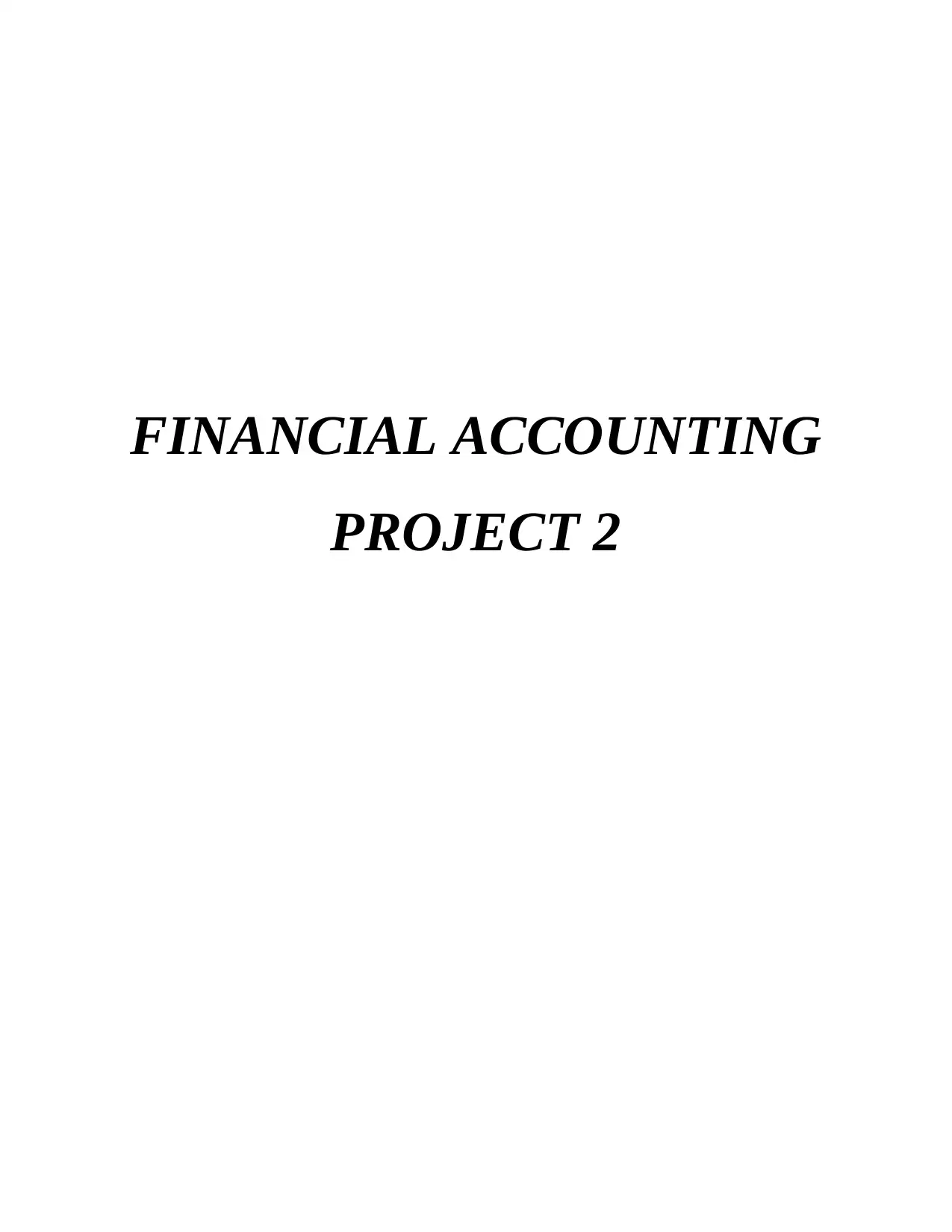
FINANCIAL ACCOUNTING
PROJECT 2
PROJECT 2
Secure Best Marks with AI Grader
Need help grading? Try our AI Grader for instant feedback on your assignments.
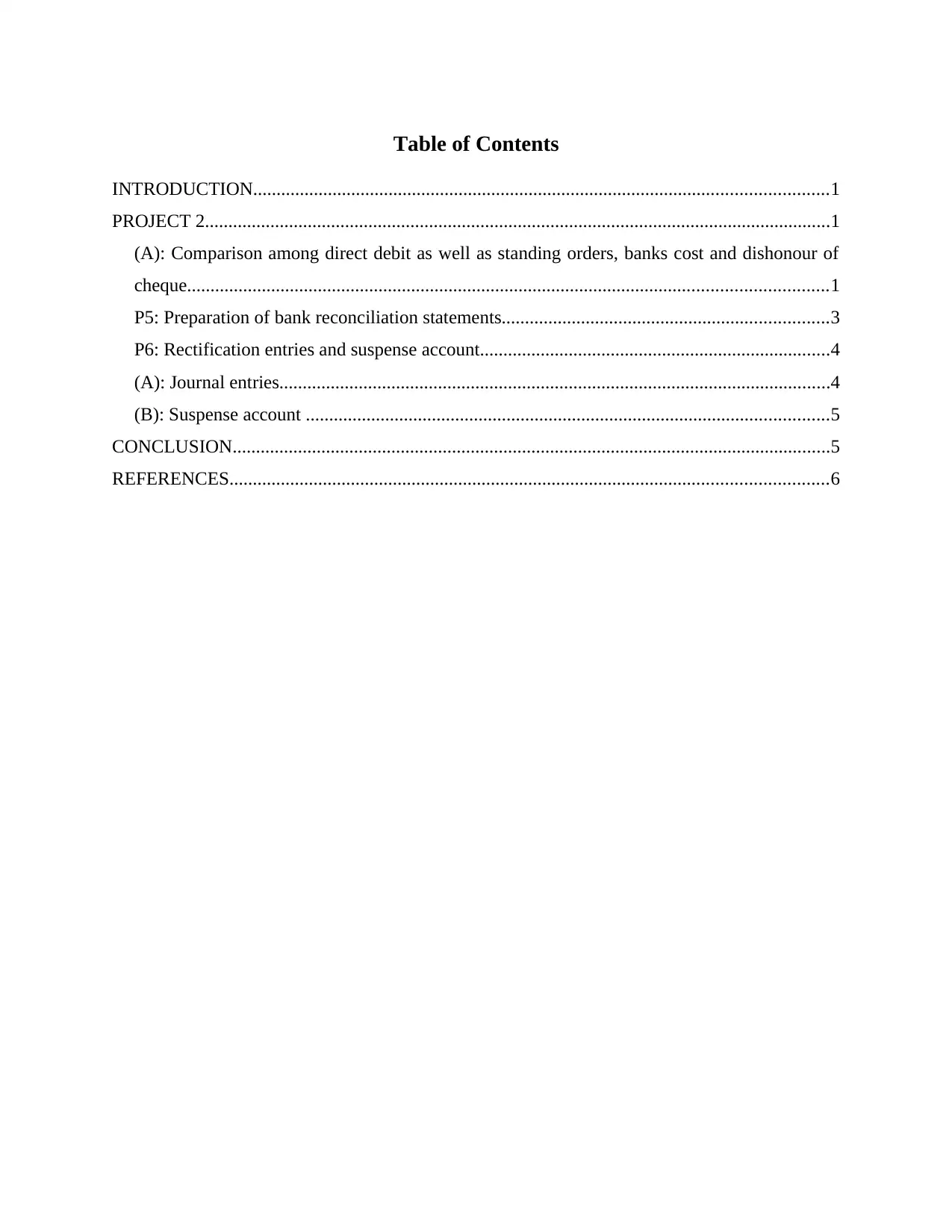
Table of Contents
INTRODUCTION...........................................................................................................................1
PROJECT 2......................................................................................................................................1
(A): Comparison among direct debit as well as standing orders, banks cost and dishonour of
cheque.........................................................................................................................................1
P5: Preparation of bank reconciliation statements......................................................................3
P6: Rectification entries and suspense account...........................................................................4
(A): Journal entries......................................................................................................................4
(B): Suspense account ................................................................................................................5
CONCLUSION................................................................................................................................5
REFERENCES................................................................................................................................6
INTRODUCTION...........................................................................................................................1
PROJECT 2......................................................................................................................................1
(A): Comparison among direct debit as well as standing orders, banks cost and dishonour of
cheque.........................................................................................................................................1
P5: Preparation of bank reconciliation statements......................................................................3
P6: Rectification entries and suspense account...........................................................................4
(A): Journal entries......................................................................................................................4
(B): Suspense account ................................................................................................................5
CONCLUSION................................................................................................................................5
REFERENCES................................................................................................................................6
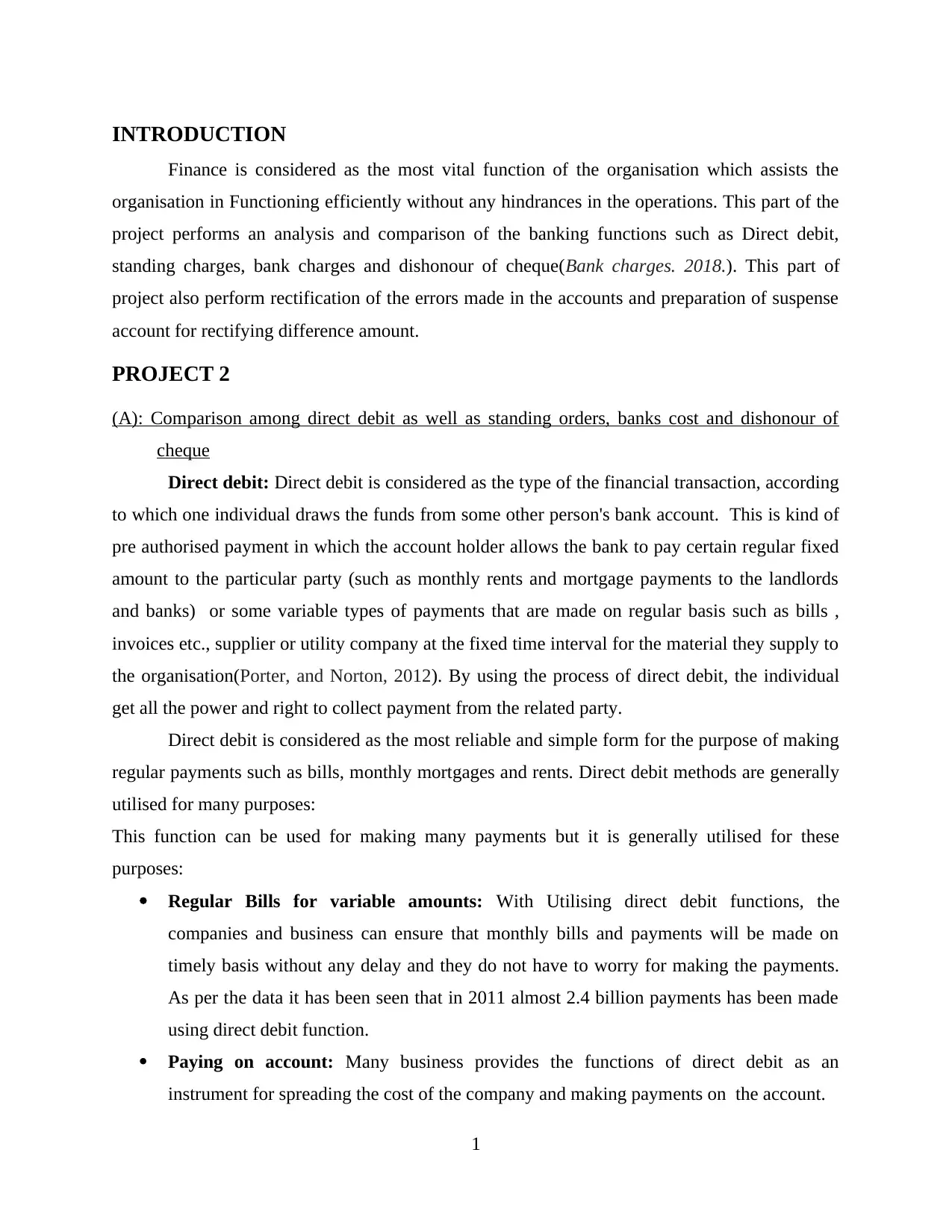
INTRODUCTION
Finance is considered as the most vital function of the organisation which assists the
organisation in Functioning efficiently without any hindrances in the operations. This part of the
project performs an analysis and comparison of the banking functions such as Direct debit,
standing charges, bank charges and dishonour of cheque(Bank charges. 2018.). This part of
project also perform rectification of the errors made in the accounts and preparation of suspense
account for rectifying difference amount.
PROJECT 2
(A): Comparison among direct debit as well as standing orders, banks cost and dishonour of
cheque
Direct debit: Direct debit is considered as the type of the financial transaction, according
to which one individual draws the funds from some other person's bank account. This is kind of
pre authorised payment in which the account holder allows the bank to pay certain regular fixed
amount to the particular party (such as monthly rents and mortgage payments to the landlords
and banks) or some variable types of payments that are made on regular basis such as bills ,
invoices etc., supplier or utility company at the fixed time interval for the material they supply to
the organisation(Porter, and Norton, 2012). By using the process of direct debit, the individual
get all the power and right to collect payment from the related party.
Direct debit is considered as the most reliable and simple form for the purpose of making
regular payments such as bills, monthly mortgages and rents. Direct debit methods are generally
utilised for many purposes:
This function can be used for making many payments but it is generally utilised for these
purposes:
Regular Bills for variable amounts: With Utilising direct debit functions, the
companies and business can ensure that monthly bills and payments will be made on
timely basis without any delay and they do not have to worry for making the payments.
As per the data it has been seen that in 2011 almost 2.4 billion payments has been made
using direct debit function.
Paying on account: Many business provides the functions of direct debit as an
instrument for spreading the cost of the company and making payments on the account.
1
Finance is considered as the most vital function of the organisation which assists the
organisation in Functioning efficiently without any hindrances in the operations. This part of the
project performs an analysis and comparison of the banking functions such as Direct debit,
standing charges, bank charges and dishonour of cheque(Bank charges. 2018.). This part of
project also perform rectification of the errors made in the accounts and preparation of suspense
account for rectifying difference amount.
PROJECT 2
(A): Comparison among direct debit as well as standing orders, banks cost and dishonour of
cheque
Direct debit: Direct debit is considered as the type of the financial transaction, according
to which one individual draws the funds from some other person's bank account. This is kind of
pre authorised payment in which the account holder allows the bank to pay certain regular fixed
amount to the particular party (such as monthly rents and mortgage payments to the landlords
and banks) or some variable types of payments that are made on regular basis such as bills ,
invoices etc., supplier or utility company at the fixed time interval for the material they supply to
the organisation(Porter, and Norton, 2012). By using the process of direct debit, the individual
get all the power and right to collect payment from the related party.
Direct debit is considered as the most reliable and simple form for the purpose of making
regular payments such as bills, monthly mortgages and rents. Direct debit methods are generally
utilised for many purposes:
This function can be used for making many payments but it is generally utilised for these
purposes:
Regular Bills for variable amounts: With Utilising direct debit functions, the
companies and business can ensure that monthly bills and payments will be made on
timely basis without any delay and they do not have to worry for making the payments.
As per the data it has been seen that in 2011 almost 2.4 billion payments has been made
using direct debit function.
Paying on account: Many business provides the functions of direct debit as an
instrument for spreading the cost of the company and making payments on the account.
1
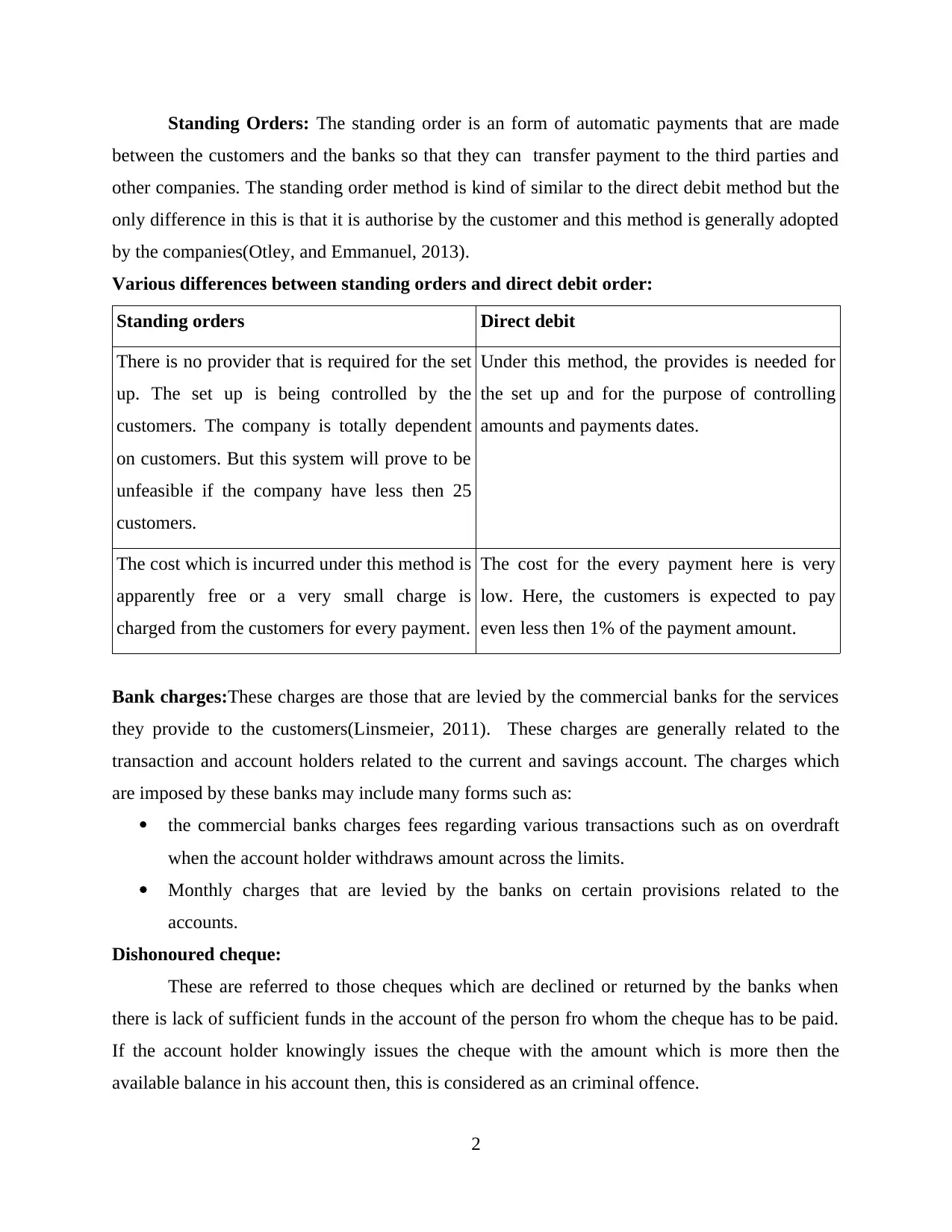
Standing Orders: The standing order is an form of automatic payments that are made
between the customers and the banks so that they can transfer payment to the third parties and
other companies. The standing order method is kind of similar to the direct debit method but the
only difference in this is that it is authorise by the customer and this method is generally adopted
by the companies(Otley, and Emmanuel, 2013).
Various differences between standing orders and direct debit order:
Standing orders Direct debit
There is no provider that is required for the set
up. The set up is being controlled by the
customers. The company is totally dependent
on customers. But this system will prove to be
unfeasible if the company have less then 25
customers.
Under this method, the provides is needed for
the set up and for the purpose of controlling
amounts and payments dates.
The cost which is incurred under this method is
apparently free or a very small charge is
charged from the customers for every payment.
The cost for the every payment here is very
low. Here, the customers is expected to pay
even less then 1% of the payment amount.
Bank charges:These charges are those that are levied by the commercial banks for the services
they provide to the customers(Linsmeier, 2011). These charges are generally related to the
transaction and account holders related to the current and savings account. The charges which
are imposed by these banks may include many forms such as:
the commercial banks charges fees regarding various transactions such as on overdraft
when the account holder withdraws amount across the limits.
Monthly charges that are levied by the banks on certain provisions related to the
accounts.
Dishonoured cheque:
These are referred to those cheques which are declined or returned by the banks when
there is lack of sufficient funds in the account of the person fro whom the cheque has to be paid.
If the account holder knowingly issues the cheque with the amount which is more then the
available balance in his account then, this is considered as an criminal offence.
2
between the customers and the banks so that they can transfer payment to the third parties and
other companies. The standing order method is kind of similar to the direct debit method but the
only difference in this is that it is authorise by the customer and this method is generally adopted
by the companies(Otley, and Emmanuel, 2013).
Various differences between standing orders and direct debit order:
Standing orders Direct debit
There is no provider that is required for the set
up. The set up is being controlled by the
customers. The company is totally dependent
on customers. But this system will prove to be
unfeasible if the company have less then 25
customers.
Under this method, the provides is needed for
the set up and for the purpose of controlling
amounts and payments dates.
The cost which is incurred under this method is
apparently free or a very small charge is
charged from the customers for every payment.
The cost for the every payment here is very
low. Here, the customers is expected to pay
even less then 1% of the payment amount.
Bank charges:These charges are those that are levied by the commercial banks for the services
they provide to the customers(Linsmeier, 2011). These charges are generally related to the
transaction and account holders related to the current and savings account. The charges which
are imposed by these banks may include many forms such as:
the commercial banks charges fees regarding various transactions such as on overdraft
when the account holder withdraws amount across the limits.
Monthly charges that are levied by the banks on certain provisions related to the
accounts.
Dishonoured cheque:
These are referred to those cheques which are declined or returned by the banks when
there is lack of sufficient funds in the account of the person fro whom the cheque has to be paid.
If the account holder knowingly issues the cheque with the amount which is more then the
available balance in his account then, this is considered as an criminal offence.
2
Secure Best Marks with AI Grader
Need help grading? Try our AI Grader for instant feedback on your assignments.
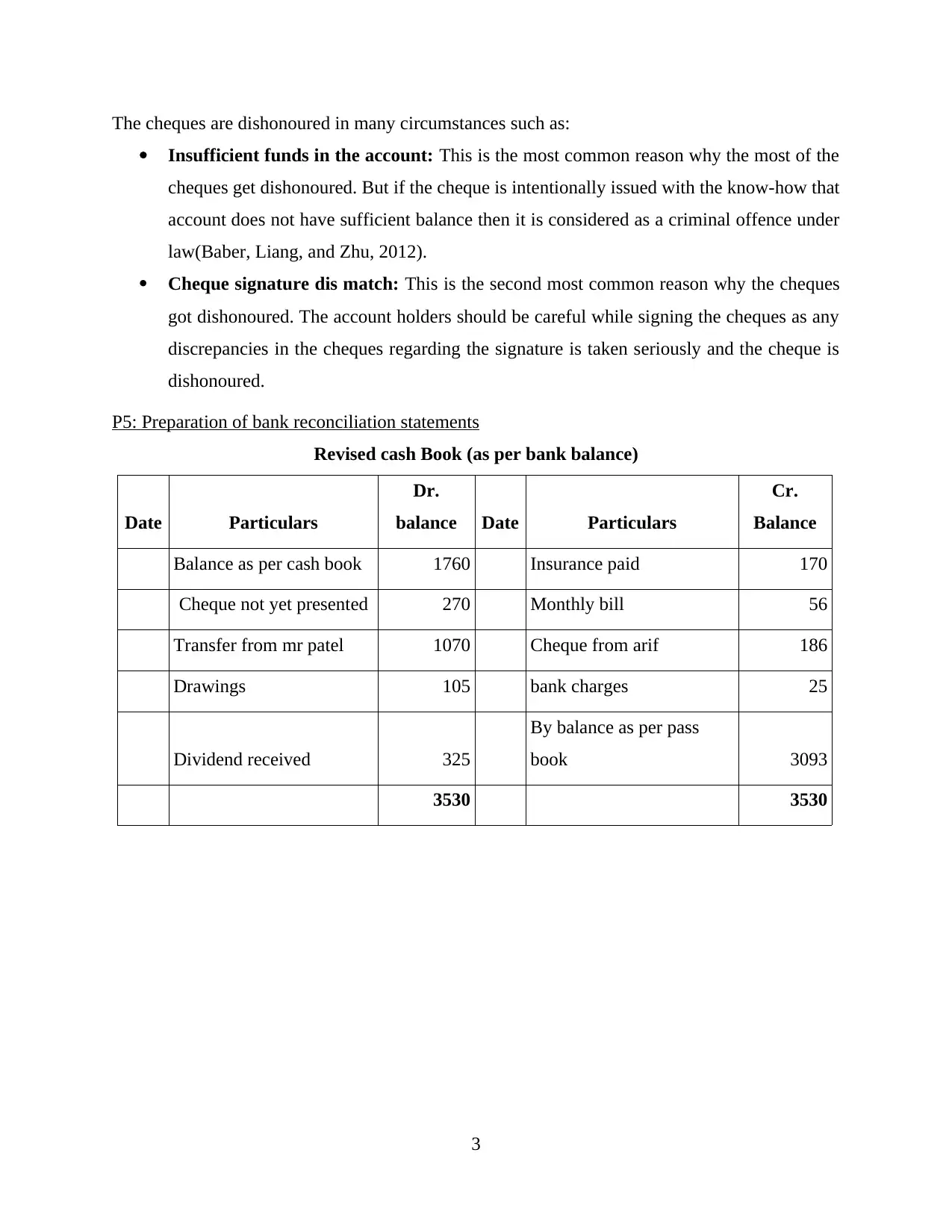
The cheques are dishonoured in many circumstances such as:
Insufficient funds in the account: This is the most common reason why the most of the
cheques get dishonoured. But if the cheque is intentionally issued with the know-how that
account does not have sufficient balance then it is considered as a criminal offence under
law(Baber, Liang, and Zhu, 2012).
Cheque signature dis match: This is the second most common reason why the cheques
got dishonoured. The account holders should be careful while signing the cheques as any
discrepancies in the cheques regarding the signature is taken seriously and the cheque is
dishonoured.
P5: Preparation of bank reconciliation statements
Revised cash Book (as per bank balance)
Date Particulars
Dr.
balance Date Particulars
Cr.
Balance
Balance as per cash book 1760 Insurance paid 170
Cheque not yet presented 270 Monthly bill 56
Transfer from mr patel 1070 Cheque from arif 186
Drawings 105 bank charges 25
Dividend received 325
By balance as per pass
book 3093
3530 3530
3
Insufficient funds in the account: This is the most common reason why the most of the
cheques get dishonoured. But if the cheque is intentionally issued with the know-how that
account does not have sufficient balance then it is considered as a criminal offence under
law(Baber, Liang, and Zhu, 2012).
Cheque signature dis match: This is the second most common reason why the cheques
got dishonoured. The account holders should be careful while signing the cheques as any
discrepancies in the cheques regarding the signature is taken seriously and the cheque is
dishonoured.
P5: Preparation of bank reconciliation statements
Revised cash Book (as per bank balance)
Date Particulars
Dr.
balance Date Particulars
Cr.
Balance
Balance as per cash book 1760 Insurance paid 170
Cheque not yet presented 270 Monthly bill 56
Transfer from mr patel 1070 Cheque from arif 186
Drawings 105 bank charges 25
Dividend received 325
By balance as per pass
book 3093
3530 3530
3
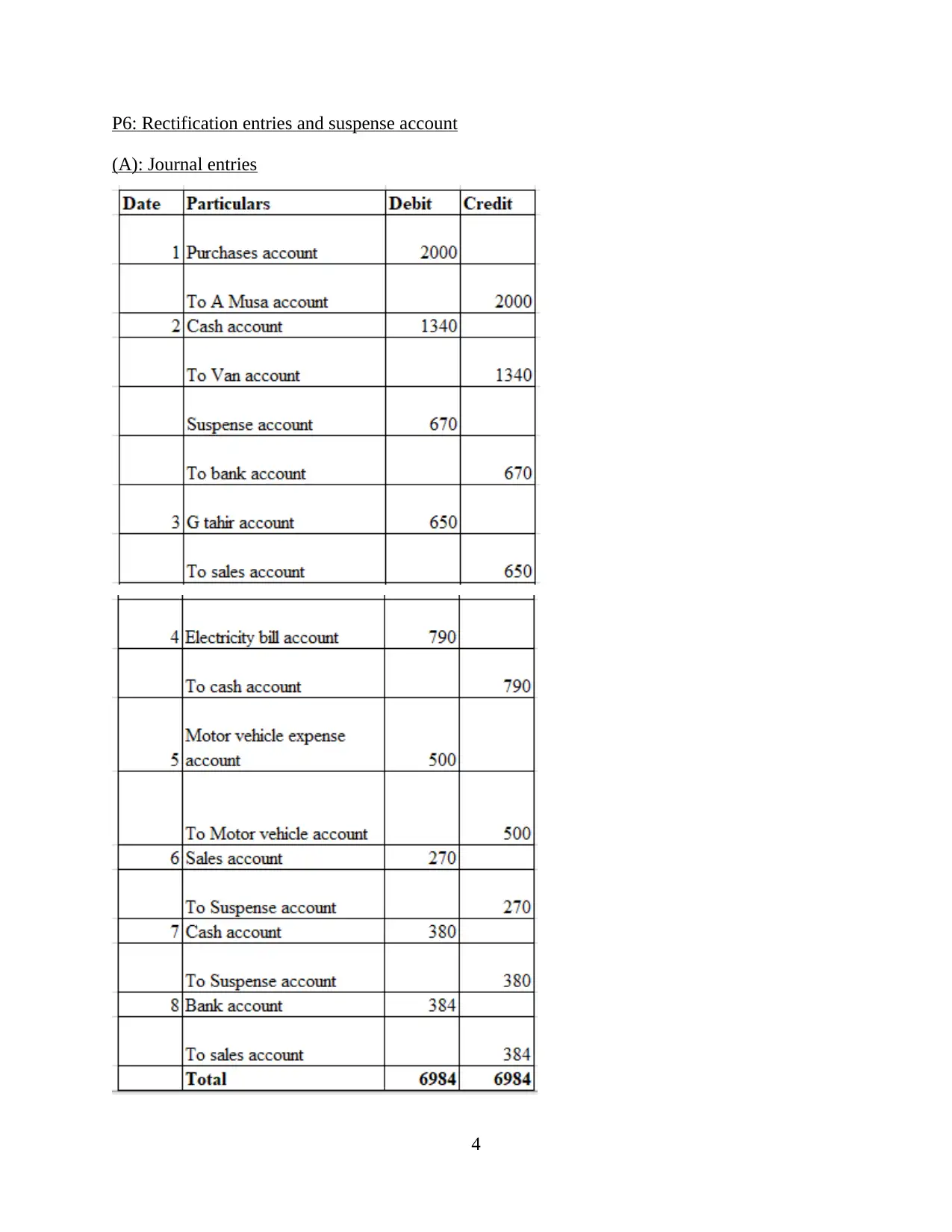
P6: Rectification entries and suspense account
(A): Journal entries
4
(A): Journal entries
4
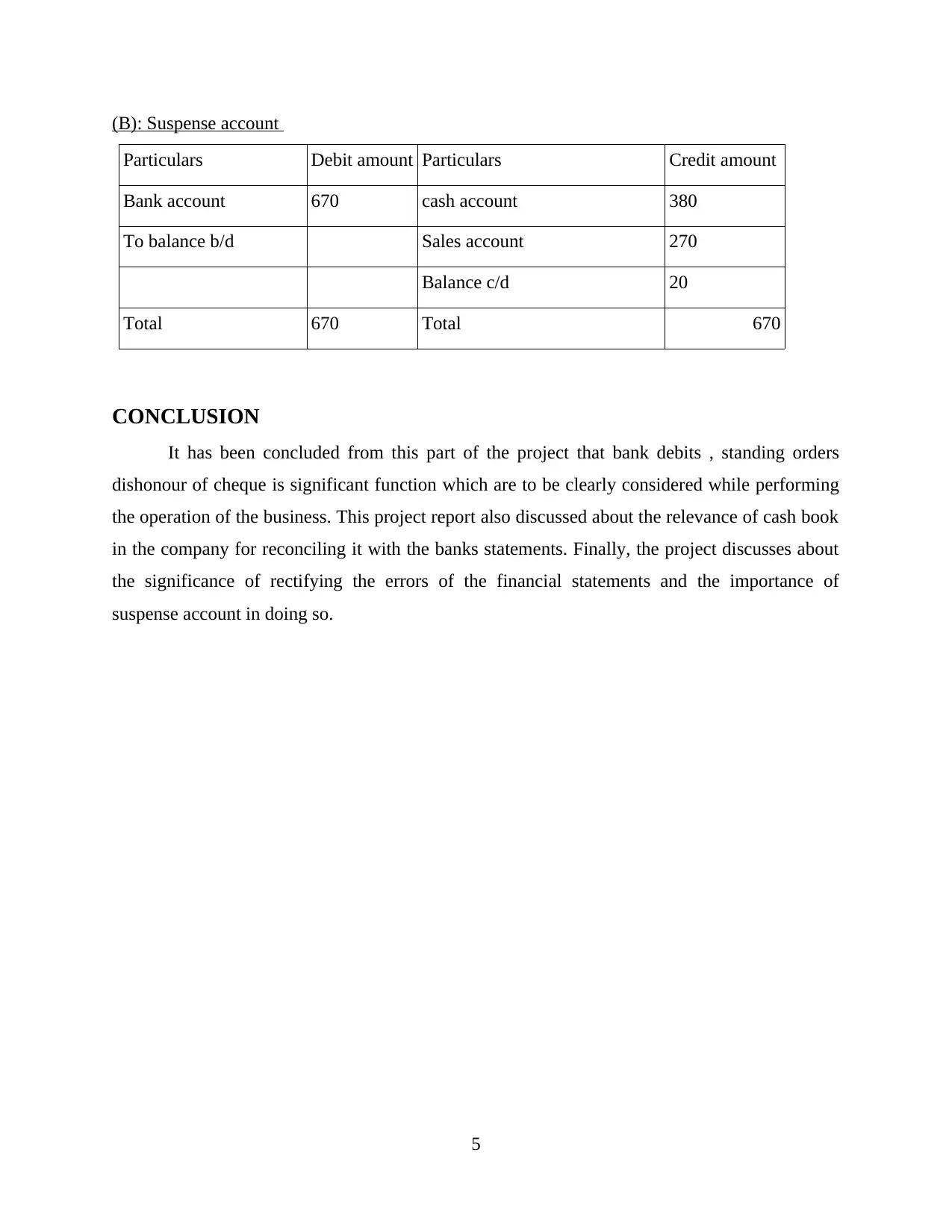
(B): Suspense account
Particulars Debit amount Particulars Credit amount
Bank account 670 cash account 380
To balance b/d Sales account 270
Balance c/d 20
Total 670 Total 670
CONCLUSION
It has been concluded from this part of the project that bank debits , standing orders
dishonour of cheque is significant function which are to be clearly considered while performing
the operation of the business. This project report also discussed about the relevance of cash book
in the company for reconciling it with the banks statements. Finally, the project discusses about
the significance of rectifying the errors of the financial statements and the importance of
suspense account in doing so.
5
Particulars Debit amount Particulars Credit amount
Bank account 670 cash account 380
To balance b/d Sales account 270
Balance c/d 20
Total 670 Total 670
CONCLUSION
It has been concluded from this part of the project that bank debits , standing orders
dishonour of cheque is significant function which are to be clearly considered while performing
the operation of the business. This project report also discussed about the relevance of cash book
in the company for reconciling it with the banks statements. Finally, the project discusses about
the significance of rectifying the errors of the financial statements and the importance of
suspense account in doing so.
5
Paraphrase This Document
Need a fresh take? Get an instant paraphrase of this document with our AI Paraphraser
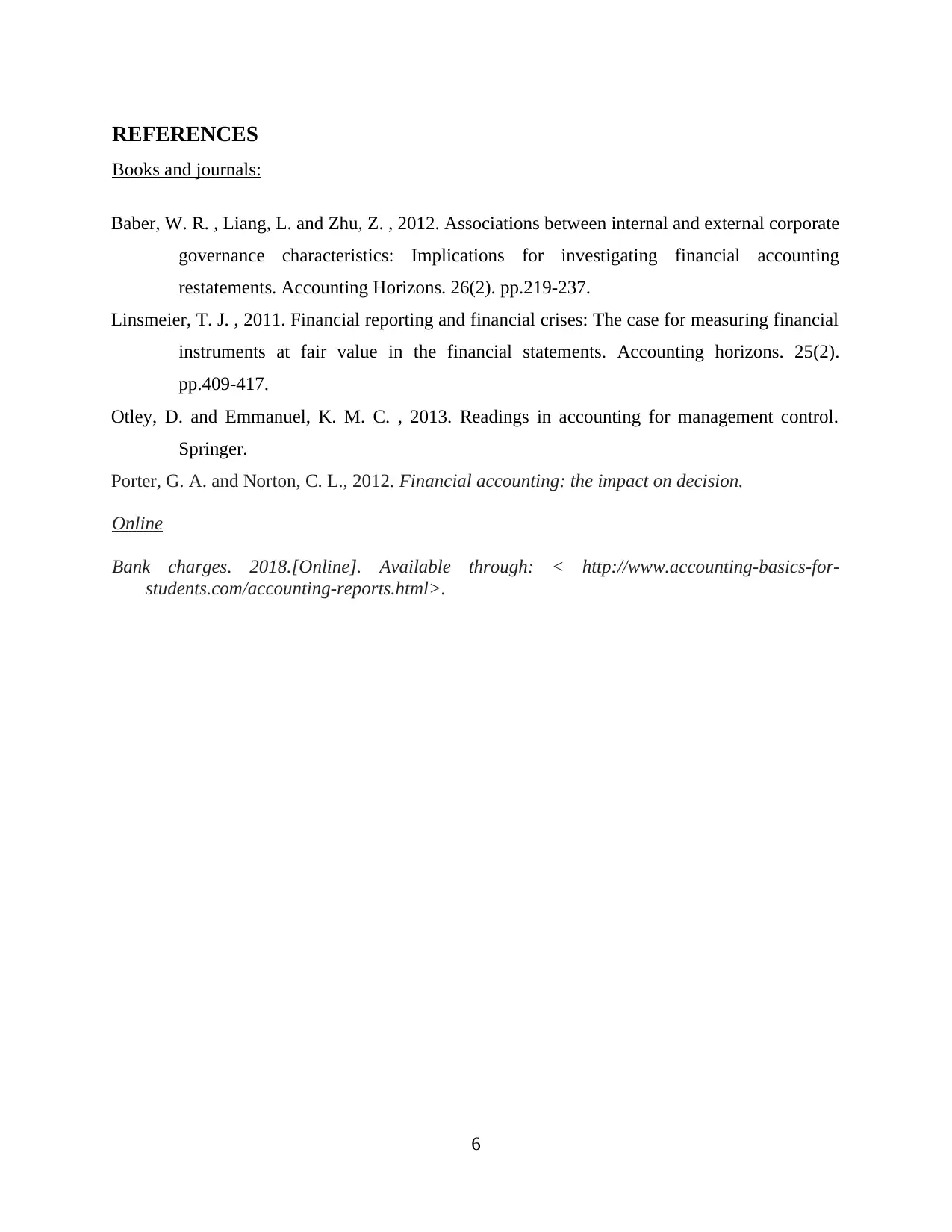
REFERENCES
Books and journals:
Baber, W. R. , Liang, L. and Zhu, Z. , 2012. Associations between internal and external corporate
governance characteristics: Implications for investigating financial accounting
restatements. Accounting Horizons. 26(2). pp.219-237.
Linsmeier, T. J. , 2011. Financial reporting and financial crises: The case for measuring financial
instruments at fair value in the financial statements. Accounting horizons. 25(2).
pp.409-417.
Otley, D. and Emmanuel, K. M. C. , 2013. Readings in accounting for management control.
Springer.
Porter, G. A. and Norton, C. L., 2012. Financial accounting: the impact on decision.
Online
Bank charges. 2018.[Online]. Available through: < http://www.accounting-basics-for-
students.com/accounting-reports.html>.
6
Books and journals:
Baber, W. R. , Liang, L. and Zhu, Z. , 2012. Associations between internal and external corporate
governance characteristics: Implications for investigating financial accounting
restatements. Accounting Horizons. 26(2). pp.219-237.
Linsmeier, T. J. , 2011. Financial reporting and financial crises: The case for measuring financial
instruments at fair value in the financial statements. Accounting horizons. 25(2).
pp.409-417.
Otley, D. and Emmanuel, K. M. C. , 2013. Readings in accounting for management control.
Springer.
Porter, G. A. and Norton, C. L., 2012. Financial accounting: the impact on decision.
Online
Bank charges. 2018.[Online]. Available through: < http://www.accounting-basics-for-
students.com/accounting-reports.html>.
6
1 out of 8
Your All-in-One AI-Powered Toolkit for Academic Success.
+13062052269
info@desklib.com
Available 24*7 on WhatsApp / Email
![[object Object]](/_next/static/media/star-bottom.7253800d.svg)
Unlock your academic potential
© 2024 | Zucol Services PVT LTD | All rights reserved.



